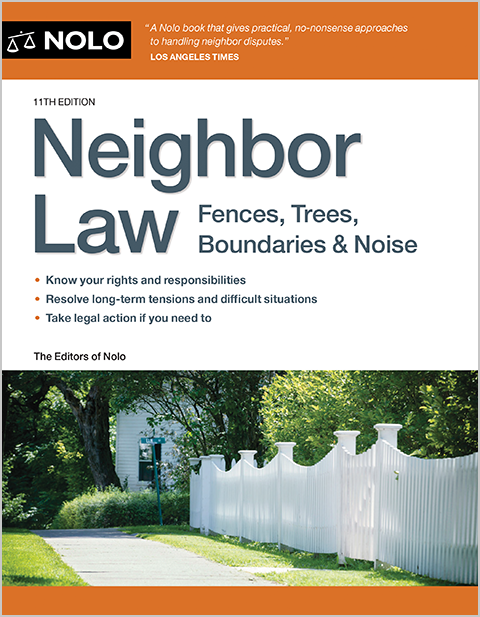A breakdown of California laws on neighbor disputes involving trees, fences, and the right to farm.
Below, you will find legal citations and a brief rundown on California statutes concerning the most common sorts of disputes with residents of properties that adjoin yours.
California Tree Damage Laws
In California, if someone damages your tree, you can recover at a minimum your actual damages (usually, what you paid for the tree or what it would cost to replace it). To learn what you must prove in order to get actual damages, see When a Neighbor Damages or Destroys Your Tree. What's more, you can recover triple damages if someone deliberately chops down or otherwise damages your tree. (Cal. Civ. Code § 3346.)
In addition, intentionally damaging a tree is a crime in California and can result in arrest, jail, fines, and other penalties. (See Cal. Penal Code § 384a.) Violators may face a misdemeanor sentence, with punishment of a fine of up to $1,000, imprisonment of up to six months, or both that.
In addition, more general California criminal statutes, such as those related to theft or property damage, may also apply. (To learn more about damages and criminal penalties in tree injury cases, see When a Neighbor Damages or Destroys Your Tree.)
Legal Consequences of
Intentionally Damaging Trees in California
|
California Statute for Additional Damages |
Additional Amount You Can Sue for in California |
California Criminal Statute |
|
Cal. Civ. Code § 3346 |
Triple damages |
Cal. Penal Code § 384a |
California Boundary Fence Laws
A boundary fence is a fence that is located on or near a property line, though the exact definition can vary by state. Sometimes even a hedge can act as a boundary. To learn more about boundary fences, including how they are defined, when a neighbor is allowed to build a boundary fence, and who is responsible for repairs and maintenance, see Fences and Neighbors FAQ.
You will find California's boundary fence statute at Cal. Civ. Code § § 841 and 841.4. As in most states, it says that adjoining landowners shall share the responsibility and costs of maintaining the fence, and must give each other notice before any new fence construction, maintenance, or replacement.
In addition, there might be a local ordinance (in your city, county, or town) that has rules on boundary fences. And your homeowners' association (HOA), if you live in a community that is governed by one, is also likely to have rules about fences (even down to their paint color).
California also prohibits "spite fences," which it defines as a fence or similar structure unnecessarily exceeding 10 feet in height that is maliciously erected or maintained in order to annoy the owner or resident. It allows lawsuits over spite fences based on a theory of "private nuisance." (See Cal. Civ. Code § 841.4.)
|
California Boundary Fence Statutes |
|
Cal. Civ. Code § § 841 and 841.4 |
California Right to Farm Laws
All states have laws that exempt farmers and other agricultural operators from complying with the nuisance laws that affect residential property owners; that is, laws that restrict certain kinds of noisy activity like operation of heavy machinery, or prohibit the use of pesticides, for example.
States vary as to how "farming" is defined and how long the agricultural operation must be in existence in order to get protection under right to farm statutes. Some states also list specific things (for example, odor, noise, or dust) that don't constitute a legal nuisance when they're a byproduct of farming or agricultural activity. You can find California's right to farm statute at Cal. Civ. Code § § 3482.5 and 3482.6. It protects from nuisance suits any commercial farm operation that has existed for more than three years if it was not a nuisance at the time it began, on condition that it be conducted or maintained in a manner consistent with proper and accepted customs and standards in the same locality.
(To learn more about right to farm statutes, see Buying a Home in the Country: Do Your Rural Neighbors Have the Right to Farm?.)
|
California Right to Farm Statutes |
|
Cal. Civ. Code § § 3482.5 and 3482.6 |
To Learn More About Neighbor Issues in California
For other articles on neighbor disputes involving adverse possessions and easements, see Adverse Possession: When Trespassers Become Property Owners and Property Easements: Overview.
To learn more about the property issues covered in this article and other disputes between landowners and neighbors, get Neighbor Law: Fences, Trees, Boundaries & Noise, by the Editors of Nolo.
Talk to a Lawyer
Need a lawyer? Start here.
How it Works
- Briefly tell us about your case
- Provide your contact information
- Choose attorneys to contact you
- Briefly tell us about your case
- Provide your contact information
- Choose attorneys to contact you


